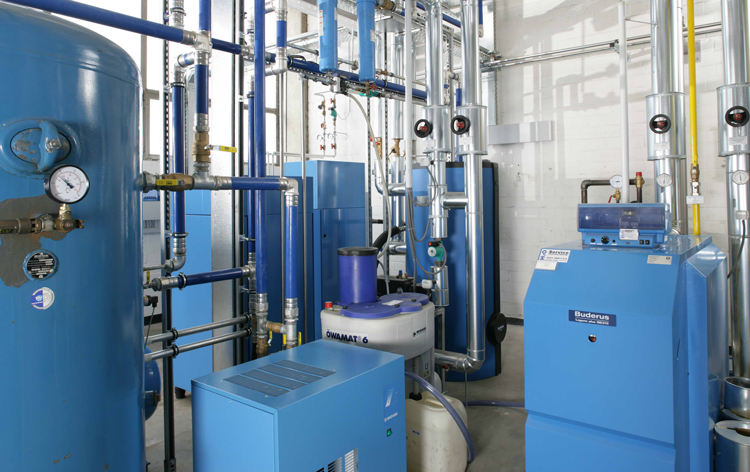Five simple steps to maximising energy efficiency
.jpg)
Though compressed air is a key element in many commercial and industrial set-ups it is extremely expensive to produce. To improve economic performance and reduce their environmental impact plant operators can adopt a few simple strategies to get the most out of their compressed air system, BOGE’s general manager, Mark Whitmore explains how.
From the garage mechanic’s ‘windy gun’ to sophisticated pneumatic manufacturing equipment, compressed air is all but ubiquitous in modern commerce and industry. Indeed, compressed air is so prevalent that its production annually accounts for some 10% of total European industrial electricity consumption. Using around 80TWh a year across the continent and more than 10TWh in the UK alone, for some operations compressed air production can account for close to a third of the total electricity use.
Even though most modern air compressors offer high mechanical efficiencies, the overall efficiency of a typical compressed air system can be as low as 10-15%, according to figures from the UK’s Carbon Trust.
There’s no doubt that compressed air is expensive to produce. Over its operational lifespan, initial capital costs account for around 15% of total expenditure for a typical air compressor, whereas energy use is more like 75%. Yet many systems are extremely inefficient and wasteful. Leaks, poor maintenance, poor control, use and misapplication add up to a significant bottom line impact.
Furthermore, there is a considerable carbon footprint associated with compressed air production. In the UK, Carbon Trust figures indicate that the sector is responsible for yearly equivalent of more than 5 million tonnes of CO2 emissions.
Minimising waste is therefore vital. But, by adopting a series of simple strategies, operators can in fact make significant savings on energy use and climate impact. Electricity savings figures of above over 30% have been reported, making energy efficiency a straightforward approach to boost the bottom line.

Energy use reduction strategy No. 1: Reduce leaks
While even brand new compressed air systems have leaks, aiming for a target of 5-10% on losses of air generated to leakage is a guide for a well-maintained system. Leakage rates on poorly maintained systems can be as much as 40-50% or higher. Addressing leakage can reduce energy losses by around 20%. With even a single 3 mm hole potentially costing over £1,000/year in wasted energy, ultrasonic leak detection equipment or even listening for leaks can be beneficial.
Energy use reduction strategy No. 2: Get the most from your compressed air
Compressed air is a valuable commodity and should be used sparingly. Alternative or more efficient solutions may be possible, such as using venturi-type nozzles fitted to blow guns which can use 30% less compressed air. Maintaining equipment and system efficiencies by changing filters more frequently. Alternatives to air driven motors for providing motion could be selected, for example without a specific requirement such as an explosion risk, an electric motor may provide a more cost-effective solution. Optimising end use devices could save up to 40% in energy use in some applications.
Energy use reduction strategy No. 3: Reduce pressure
Compressed air systems typically run at full pressure, perhaps 100psi (7 bar). Often this is unnecessary and reducing pressure by even 1 bar could save 7% in electricity costs. Using multi-pressure systems or smaller booster compressors where limited amounts of higher pressure air is required is an attractive approach.
Energy use reduction strategy No. 4: Enhance system efficiency
Overall system efficiency can typically benefit from a number of upgrades. Reducing frictional losses by increasing pipe diameters, for example, could save perhaps 3% on the electricity bill. More significant are the opportunities available by improving compressor drives with more efficient motors and better speed control. Given that fixed-speed compressors can consume 20-70% of their full load power even when idling, optimising the systems drives can yield big savings. It may even make sense to upgrade the compressor unit. Capital expenditure on a more efficient unit with a better control system could easily be offset by energy savings in some applications.
Alongside drives, improving cooling, drying and filtering represents another gain, as does potentially recovering the heat generated during the compression cycle.
Energy use reduction strategy No. 5: Adopt more sophisticated controls
Control solutions that are able to adapt to work loads, control multiple stages of compressor units as and when required and deliver precise pressures on demand can also allow optimisation of the compressed air system. Such systems facilitate the use of several smaller pumps rather than a single large unit, for instance, while still making compressor availability match demand as closely as possible and thus saving energy.
More advanced technologies, enabled by Industry 4.0 technologies, now allow predictive maintenance, remote system analysis and a host of other monitoring, auditing and further optimisation opportunities.
Compressed air is a vital industrial resource but compressing air is expensive. That’s only set to increase as electricity prices rise and policymakers further target large energy consumers to address their carbon footprint. Taking a few simple steps to improve compressed air efficiency can yield big dividends, not just for profitability but, perhaps more important, to address the vital need to curb energy consumption where possible. Running energy efficient systems will inevitably become more and more important in the future, but it is also important now.
Similar articles
More from BOGE Compressors
- Five simple steps to maximising energy efficiency 17th June 2019
- Hanover debut for anniversary edition S-4 screw compressor 11th February 2019
- Compressor package slashes manufacturer's energy costs 2nd August 2017
- Continued growth leads to expansion for compressed air specialist 25th July 2017












Write a comment
No comments